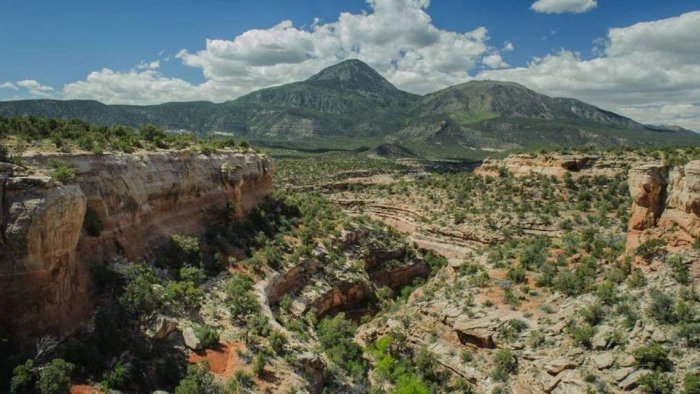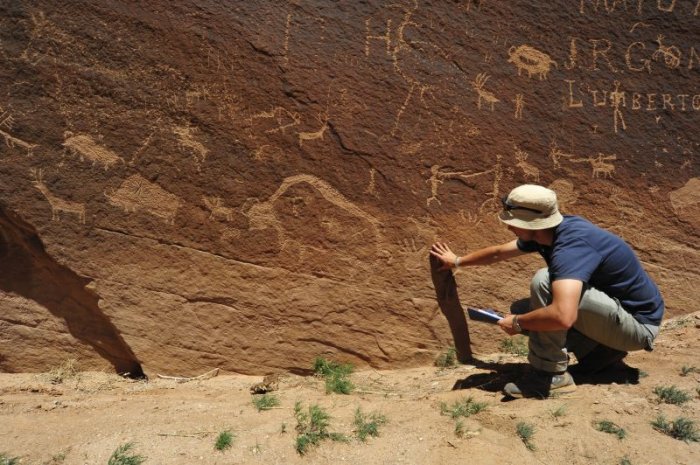Conny Waters - AncientPages.com - Polish archaeologists investigated the Castle Rock Pueblo settlement complex in Colorado and made a discovery that exceeded their “wildest expectations.”
Archaeologists exploring in Colorado discovered ancient rock carvings belonging to the Pueblo people. Credit: Jagiellonian University
"Our findings from the current year completely change our perception of this settlement area in many different aspects," says Professor. Radoslaw Palonka from the Institute of Archaeology of the Jagiellonian University, who for more than a dozen years has been investigating historic sites and customs of the 3000-year-old Pueblo culture on the border between Colorado and Utah. His team is the only Polish and one of the few European archaeological groups to work in the region.
About 2,600 feet above the ancient Pueblo cliff settlements, the scientists came across a remarkable collection of “huge rock panels” stretching about 2.5 miles around a large plateau.
A large collection of unknown petroglyphs were found. Credit: Jagiellonian University
The Castle Rock Pueblo settlement complex, located on the picturesque Mesa Verde plateau on the border between Colorado and Utah, is of great interest to many people. These areas are popular not only with archaeologists but also with tourists because of the famous Pre-Columbian settlements built in rock niches or carved into canyon walls, as well as numerous works of rock art created by members of the ancient Pueblo culture, which date back to nearly 3 thousand years ago and is still present almost exactly in the same area.
Credit: Jagiellonian University
The agricultural Pueblo communities developed one of North America's most advanced pre-Columbian cultures. They perfected the craft of building multistorey stone houses, resembling medieval townhouses or even later blocks of flats. The Pueblo people were also famous for their rock art, intricately ornamented jewelry, and ceramics bearing different motifs painted with a black pigment on a white background", says Professor Palonka.
Credit: Jagiellonian University
The discoveries of his team include previously unknown huge galleries and petroglyphs dated to various historical periods. The oldest of them, showing warriors and shamans, are estimated to date back to as early as the 3rd century AD, the period known as the Basketmaker Era. Members of this culture lived mainly on flatlands in semi-subterranean pit houses, sometimes surrounded by wooden stockades. They were engaged in farming and produced characteristic baskets and mats. Most petroglyphs come from the 12th and 13th century. They have different forms, including complicated geometric shapes.
Credit: Jagiellonian University
In the 15th-17th century, when the Ute tribe inhabited the area, the rock panels started to feature large narrative hunting scenes showing bison, mountain sheep, and deer hunts. In later centuries, they also depicted horses, which reflected the events of the Spanish conquest, before which these animals were unknown to Native North Americans (they disappeared from this continent during the last ice age). The newest pieces of rock art include the 1936 signature of Ira Cuthair, a famous cowboy renowned not only in Utah or Colorado but also in Arizona and New Mexico.
"This year I would like to conclude our research in the first area, which we have been exploring from the very beginning. It was previously studied by Americans and consists of three canyons – Sand Canyon, Graveyard Canyon, and Rock Creek Canyon. I used to think that we studied this area thoroughly, conducting full-scale excavations, geophysical surveying and digitalisation.
Yet, I had some hints from older members of the local community that something more can be found in the higher, less accessible parts of the canyons. We wanted to verify this information, and what we found surpassed our wildest expectations. It turned out that about 800 meters above the cliff settlements, there are a lot of previously unknown petroglyphs. The huge rock panels stretch over 4 kilometers around the large plateau.
Spirals up to one metre in diameter had been carved into them by the Pueblo People, who used these petroglyphs for astronomical observations and to determine the dates of some special days in the calendar: summer and winter solstices as well as spring and autumn equinoxes.
These discoveries forced us to adjust our knowledge about this area. Definitely, we have underestimated the number of inhabitants who lived here in the 13th century and the complexity of their religious practices, which must have also taken place next to these outdoor panels", says Professor Palonka.
The JU archaeologist hopes that the Mesa Verde plateau still holds many secrets, unraveling which will lead to new sensational discoveries. This year’s LiDAR surveying was conducted by researchers from the University of Houston, Texas, who use drones, helicopters, and airplanes for scanning and mapping.
Several years ago, their findings made the headlines after they had discovered 60 thousand previously unknown pyramids, temples, palaces, houses, roads, channels, and fortifications built by the Maya, covered by tropical vegetation, and marked them on a unique 3D map.
The Pueblo people lived in settlements carved into rock niches and canyon walls. Credit: Jagiellonian University
"They are the world’s top experts in LiDAR research. For three hours, they flew an airplane over three canyons at an altitude of 450 meters, based on which they will create a detailed 3D map of the area with a resolution of 5-10 centimeters, while the maps we’ve had at our disposal so far have had a resolution of one meter. We are waiting for the final results of their work and hope to spot new, previously unknown sites, mainly from earlier periods", explains Professor Radoslaw Palonka in a press release.
One of the important aspects of the Polish research on the area of the Canyons of the Ancients National Monument was the start of collaboration with the Native American local communities living in nearby reservations, including members of the Hopi and Ute tribes.
See also: More Archaeology News
The Ute are represented by the tribal archaeologist Rebecca Hammond. Members of the native tribes are keenly interested in the history of their ancestors and have repeatedly helped JU researchers understand the iconography, rock art, and the functions of some buildings. The recorded conversations will be part of the permanent multimedia exhibition in the Canyon of the Ancients Visitor Centre and Museum, where the current findings of the archaeologists from Kraków will also be presented.
Written by Conny Waters - AncientPages.com Staff Writer








